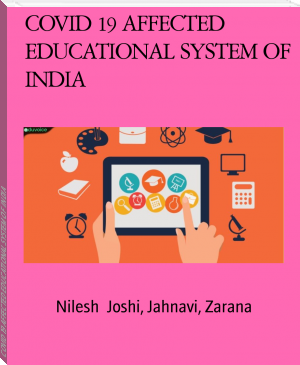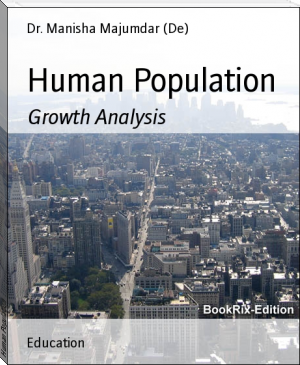COVID 19 AFFECTED EDUCATIONAL SYSTEM OF INDIA, Nilesh Joshi, Jahnavi, Zarana [macos ebook reader .txt] 📗

- Author: Nilesh Joshi, Jahnavi, Zarana
Book online «COVID 19 AFFECTED EDUCATIONAL SYSTEM OF INDIA, Nilesh Joshi, Jahnavi, Zarana [macos ebook reader .txt] 📗». Author Nilesh Joshi, Jahnavi, Zarana
COVID-19 in India: Education disrupted and lessons learned
In India, 320 million students have been affected by COVID-19 school closures, and though the government quickly recommended shifting to “online teaching,” this ignores India’s immense digital divide—with embedded gender and class divides. The 2017-18 National Sample Survey reported only 23.8 percent of Indian households had internet access. In rural households (66 percent of the population), only 14.9 percent had access, and in urban households only 42 percent had access. And males are the primary users: 16 percent of women had access to mobile internet, compared to 36 percent of men. Young people’s access is even less: A recent news report stated only 12.5 percent of students had access to smartphones. Furthermore, most teachers are ill-equipped for online .
STUDY HALL EDUCATIONAL FOUNDATION’S RESPONSE
This crisis has been a test of the Study Hall Educational Foundation’s (SHEF) skills, agility, and resilience. But because we’ve always taken a holistic approach to education, SHEF—the educational institution where I am founding president and CEO—was well-prepared to respond quickly and adaptively to the inequitable impacts of the coronavirus crisis on the vulnerable and disadvantaged.
A holistic response to whole lives
Teachers at SHEF have always looked at their students as “whole persons” and invited them to bring their whole lives into the classroom, with all the challenges. When the country first went into lockdown, teachers connected with their students by every means possible. This was a challenging task for three-quarters of our teachers whose students were on the wrong side of the digital divide, though teachers were able to connect with about half of their students’ families via mobile phones. Teachers galvanized other teachers and students, alumni, and parents to help track down their remaining students, eventually managing to connect with nearly 70 percent of our student body.
If it takes a village to raise a child, we must empower the village to teach the child.
After making contact, teachers then focused on fear management by spreading accurate information about the crisis, dispelling myths, urging caution, and diffusing panic. Then they found out what the students and families needed. Many students’ families had lost livelihoods, had no savings, and needed food. Teachers created an e-flyer with government relief measures, helplines, and locations, and personally helped provide rations and cooked food for those families without documents to access relief services.
Using digital volunteers to teach in a limited environment
Once these basic needs were taken care of, teachers then used whatever digital means were available to teach their students. Teachers galvanized an army of digital volunteers in the communities tasked with sharing the information on their devices to students without access to technology. To reach those low-tech students, teachers used voice messages, text messages, and phone calls. For high-tech students (i.e. with smartphones), teachers sent longer videos and used WhatsApp groups for discussions. To reach girls, most of whom had no access to phones, teachers even called fathers to ask how they were doing and to enlist their support for their daughters’ education. So far, the majority of fathers have responded positively, demonstrating how this crisis might be a great opportunity to develop positive relationships with fathers that improve their daughters’ education and well-being.
LESSONS LEARNED
While lamentable, the disruption to education systems worldwide offers valuable lessons and provides a unique opportunity to reimagine education, the curriculum, and pedagogy.
Address the digital divide.Technology has the potential to achieve universal quality education and improve learning outcomes. But in order to unleash its potential, the digital divide (and its embedded gender divide) must be addressed. Digital capabilities, the required infrastructure, and connectivity must reach the remotest and poorest communities. Access to technology and the internet is an urgent requirement in the information age. It should no longer be a luxury.
Reorient the curriculum.While teachers are struggling to learn digital ways of communicating with their students, it is clear that we need to pay close attention to what we teach. Our endeavor to educate children has been guided by the question “Who am I and what is my relationship with the universe and others in it?” This question has taken on even greater relevance during the crisis while decontextualized academic learning and a disproportionate focus on facts and information have been downgraded. This crisis is teaching us that curricula must be grounded in students’ realities, cultivating critical, creative, and flexible thinking, resilience, and empathy in students. Developing a symbiotic relationship with our environment has taken on a new urgency, and teachers must help students think about their relationship with the universe and everyone and everything in it.
SHEF has demonstrated how the development of social and political consciousness by students should be a major goal of education, and that lessons of equality and core democratic values should be given as much, if not more, importance in the official curricula than math, science, and language lessons. Now is the time for governments to integrate such a curriculum into the national curricular framework.
Empower a wider cadre of teachers.This crisis is forcing teachers to reinvent their roles from that of transferring information to enabling learning. The shift to distance learning has afforded many opportunities to teach differently, encouraging self-learning, providing opportunities to learn from diverse resources, and allowing customized learning for diverse needs through high-tech and low-tech sources.
But continuing education amid school closures has also taught us an important lesson about the role of the community in teaching our children. If it takes a village to raise a child, we must empower the village to teach the child. Improving the education system requires a decentralized, democratic community-based approach, where community ownership of education is cultivated. Important for this is the hiring of local teachers (with adequate Dalit and female representation), which increases teachers’ accountability to children’s families and their ability to empathize with students’ lives.
If COVID-19 school closures and their related challenges with distance learning have taught us anything, it is that we must liberate learning from outdated curricula and the disproportionate emphasis on information transfer.
Chapter 2 COVID-19 Pandemic: Impact and strategies for education sector in India
COVID-19 Pandemic: Impact and strategies for education sector in India
The pandemic has significantly disrupted the higher education sector as well, which is a critical determinant of a country’s economic future. A large number of Indian students—second only to China—enroll in universities abroad, especially in countries worst affected by the pandemic, the US, UK, Australia and China. Many such students have now been barred from leaving these countries. If the situation persists, in the long run, a decline in the demand for international higher education is expected.
The bigger concern, however, on everybody’s mind is the effect of the disease on the employment rate. Recent graduates in India are fearing withdrawal of job offers from corporates because of the current situation. The Centre for Monitoring Indian Economy’s estimates on unemployment shot up from 8.4% in mid-March to 23% in early April and the urban unemployment rate to 30.9%.
Needless to say, the pandemic has transformed the centuries-old, chalk–talk teaching model to one driven by technology. This disruption in the delivery of education is pushing policymakers to figure out how to drive engagement at scale while ensuring inclusive e-learning solutions and tackling the digital divide.
A multi-pronged strategy is necessary to manage the crisis and build a resilient Indian education system in the long term.
One, immediate measures are essential to ensure continuity of learning in government schools and universities. Open-source digital learning solutions and Learning Management Software should be adopted so teachers can conduct teaching online. The DIKSHA platform, with reach across all states in India, can be further strengthened to ensure accessibility of learning to the students.
Two, inclusive learning solutions, especially for the most vulnerable and marginalized, need to be developed. With a rapid increase of mobile internet users in India, which is expected to reach 85% households by 2024, technology is enabling ubiquitous access and personalization of education even in the remotest parts of the country. This can change the schooling system and increase the effectiveness of learning and teaching, giving students and teachers multiple options to choose from. Many aspirational districts have initiated innovative, mobile-based learning models for effective delivery of education, which can be adopted by others.
Three, strategies are required to prepare the higher education sector for the evolving demand–supply trends across the globe—particularly those related to the global mobility of students and faculty and improving the quality of and demand for higher studies in India. Further, immediate measures are required to mitigate the effects of the pandemic on job offers, internship programs, and research projects.
Four, it is also important to reconsider the current delivery and pedagogical methods in school and higher education by seamlessly integrating classroom learning with e-learning modes to build a unified learning system. The major challenge in EDTech reforms at the national level is the seamless integration of technology in the present Indian education system, which is the most diverse and largest in the world with more than 15 lakh schools and 50,000 higher education institutions. Further, it is also important to establish quality assurance mechanisms and quality benchmark for online learning developed and offered by India HEIs as well as e-learning platforms (growing rapidly). Many e-learning players offer multiple courses on the same subjects with different levels of certifications, methodology and assessment parameters. So, the quality of courses may differ across different e-learning platforms.
Five, Indian traditional knowledge is well known across the globe for its scientific innovations, values, and benefits to develop sustainable technologies and medicines. The courses on Indian traditional knowledge systems in the fields of yoga, Indian medicines, architecture, hydraulics, ethnobotany, metallurgy and agriculture should be integrated with a present-day mainstream university education to serve the larger cause of humanity.
In this time of crisis, a well-rounded and effective educational practice is what is needed for the capacity-building of young minds. It will develop skills that will drive their employability, productivity, health, and well-being in the decades to come, and ensure the overall progress of India.
Chapter 3 Covid-19: 4 negative impacts and 4 opportunities created for education





Comments (0)